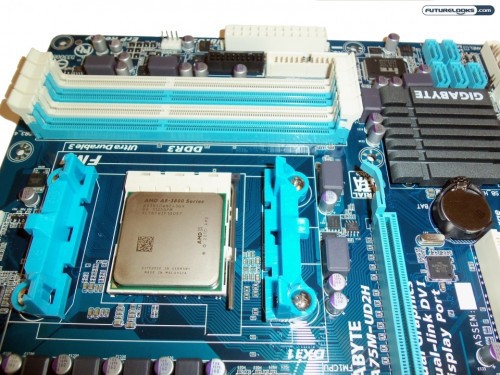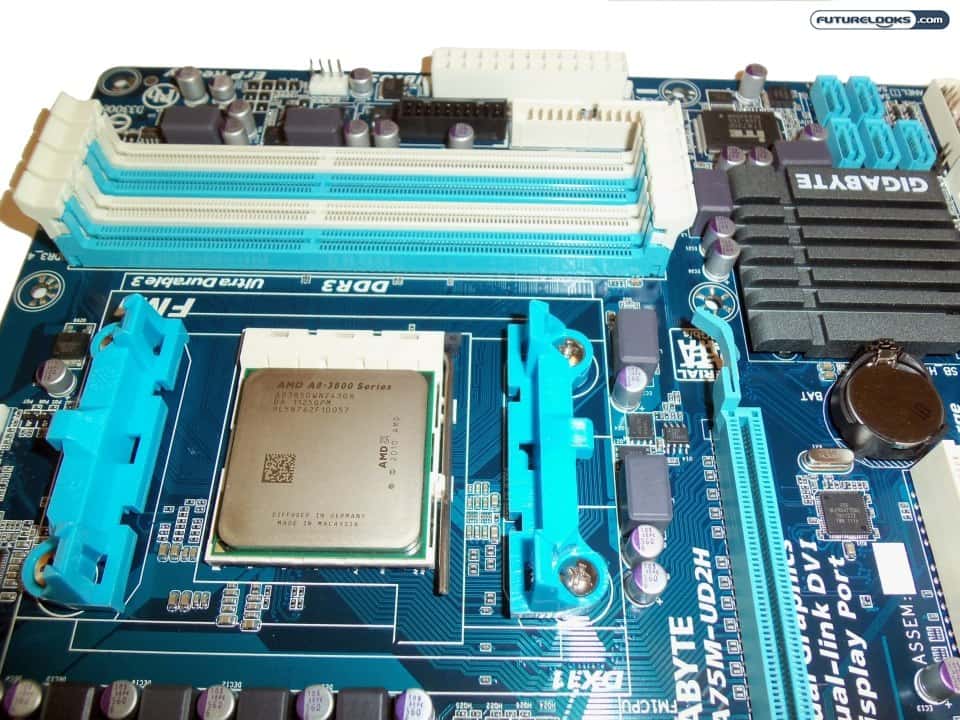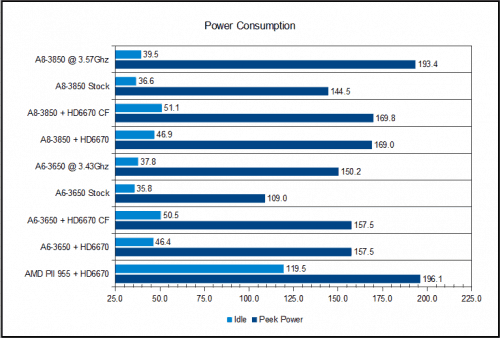Power Consumption
These numbers are for total power consumed. The tests were done at the wall socket and corrected according to the tested efficiency of the Antec HCP 850W. The efficiency measurements are an aggregate collection of data from several websites to review the Antec HCP 850W.
While the Phenom II does power throttle, it is nothing when compared to an APU. At idle the Phenom II 955 has a higher power draw than the A6-3650 at max load. In their idle state, the APUs quickly drop to 800 Mhz via a multiplier change and 0.9V instead of 1.4V at load. The APU makes up the 2 most power hungry components in a computer, so you get a drastic drop in overall power consumption at idle. It is also clear the extra 80 SIMPs and 4 texture units in the 6550D does come at the cost of slightly higher power draw.
Final Thoughts

The CPU side of this chip is a die shrunken version of the AMD Athlon II processors with twice the cache and an improved memory controller. While they help to get performance closer to a Phenom II, there is a gap. There is no perceivable difference in performance when you are just browsing the web, listing to music, writing documents, or playing web games.
Graphics performance is another story. The 6550D and 6530D are hands down the most powerful IGPs on the market. Futurelooks i7 2600k and i5 2500k review shows in Resident Evil 5 DX10 at 720p, the Intel 3000 IGP can only give a meager 17.4 FPS. The A6-3650 on-die 6530D can play Resident Evil 5 DX10 at 1080p at 30.1 FPS.
As for price, you can build a cheaper system with similar performance using an AM3 board at around $45, a $90 AMD Propus, and an HD 6570 for $70, totaling to $205. An A8-3850 and the GIGABYTE A75M-UD2H in my test total to $240. The extra $35 gets you four native USB 3.0 ports, five SATA III (6 Gb/s), and a better memory controller.
The only down side to an APU based PC is the current lack of upgrade paths. AMD has plans for several forthcoming APUs including a Bulldozer APU named Trinity, but it is not clear if new APUs will use the same FM1 socket.
The A8-3850 (MSRP of $139.99) and the A6-3650 (MSRP of $119.99) are well worth every dime, especially since you get the equivalent of a $70 dedicated GPU on-board. If you are on a strict budget, want to build a powerful small form factor PC, or plan to play games on a PC you bought from a retailer, the AMD Llano APUs are what you want to own. An APU PC also can be a very compelling “daily driver” system that complements a powerful Sandy Bridge or even an AMD Phenom II X6 system you use for games and/or heavy lifting.
If you already have your AMD APU based system and are still looking for a bit more performance, start with your RAM as it seems to improves everything, not just graphics. We’ll be looking at this aspect of performance in another article.
I don’t think you can be anything but surprised with this platform. Especially once you get either APU plugged in and working as a daily driven system. I know a few of us at Futurelooks have been pleasantly surprised, especially with the lack of noise and heat. AMD’s latest APU platforms certainly represent a new way of looking at value and come highly recommended from Futurelooks.
Pros
- Unparalleled Integrated Graphics Performance
- Much Improved Memory Controller
- Priced Well
- Low Power Use
- CrossFireX Support in DX10 and DX11
- Complemented Well by Hudson FCH
- Eyefinity up to 3 Monitors
Cons
- No CrossFireX Support in DX9
- Crossfire Drivers Need Work
- Small Performance Improvement over Athlon II CPUs
- Unique Socket Limits Upgrade Paths
Overall Score: 8.5 / 10


Help Us Improve Our Reviews By Leaving a Comment Below!


